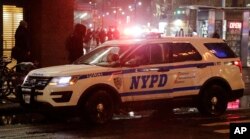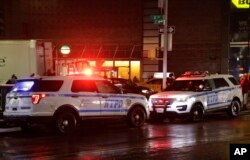If two New York City lawmakers get their way, the long, droning siren from police cars, fire trucks and ambulances that has been part of the city's soundtrack for generations — WAAAAAhhhhhhh — would be replaced by a high-low wail similar to what's heard on the streets of London and Paris — WEE-oww-WEE-oww-WEE-oww.
Their reasons for the switch: The European-style siren is less shrill and annoying and contributes less to noise pollution.
“I’ve been hearing from constituents complaining that the current sirens in New York are a high-pitched, continuous noise — a nuisance,” says Helen Rosenthal, an Upper West Side Democrat and one of the sponsors of the proposal.
Noise is consistently among the most frequent complaints to the city's hotline, with many calls about the loud sirens that blare 24/7, wake people from their slumber and cause dogs to howl in unison.
“Europeanizing” New York sirens would not change the decibel level — still topping out at roughly 118 — but would lower the frequency and thus make the sirens less shrill but still ear-catching enough to grab attention.
“The alternating high-low siren required by this legislation is not as piercing,” adds co-sponsor Carlina Rivera, a Manhattan Democrat.
If approved in a council vote — which has yet to be scheduled — the legislation would require sirens on all emergency vehicles to transition within a two-year period.
Buzz about the bill even made it to last week's NBC “Saturday Night Live,” where a “Weekend Update” anchor joked that with the European-style siren, “You can spend your ride in the ambulance pretending you have universal health care.”
City council members are looking closely at the experience of the city's Mount Sinai Health System, which already uses the two-tone siren in its 25 ambulances that make about 100,000 trips a year. The switch was made last year after decades of complaints from residents of the Upper East Side home of the hospital complex.
At community board meetings, Mount Sinai's Emergency Medical Services Director Joseph Davis played various siren options to find out which one locals preferred.
“People hated them all,” Davis said, “but the `high-low' was least intrusive. It didn't have that piercing sound.”
Davis, a 40-year EMS veteran who suffers from hearing damage that he blames on repeated exposure to sirens, said the change was simple and cost effective: All it took was reprogramming the electronic box in each vehicle, which comes preloaded with seven different sounds with names such as “Wail,” “Yelp” and “Piercer.”
In fact, many ambulances, fire trucks and police cars are equipped with alternate sirens and horns that they can employ in certain situations, such as in traffic when cars and pedestrians just won't get out of the way. They include short blips and the “Rumbler” low-frequency, vibrating siren aimed at motorists who may otherwise be unable to hear higher frequencies.
For some Manhattanites, any change in the city's daily siren song would be welcomed.
“I always have to cover my ears with my hands when a siren-blaring ambulance passes,” says Louise Belulovich, a Manhattan attorney. “If I'm carrying packages and unable to, then what is an annoying experience becomes a painful one.''
But Linda Sachs, a longtime resident of Manhattan's Upper West Side who lives near one of the Mount Sinai hospitals that uses the new European siren, doesn't think the change is for the good. She prefers the old New York standard.
“The old sirens never woke me up, but these make me shudder,” Sachs says, adding that she understands city lawmakers are attempting to do something about noise pollution. “But the old sound wasn't as obnoxious.”











